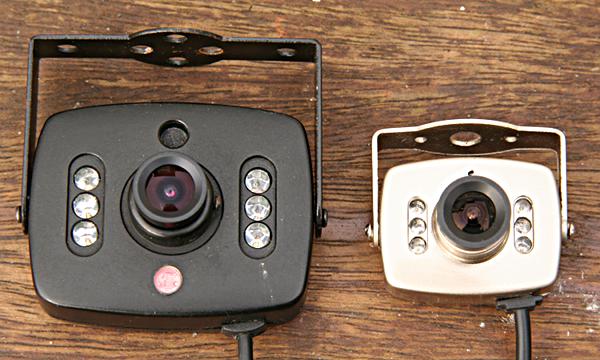
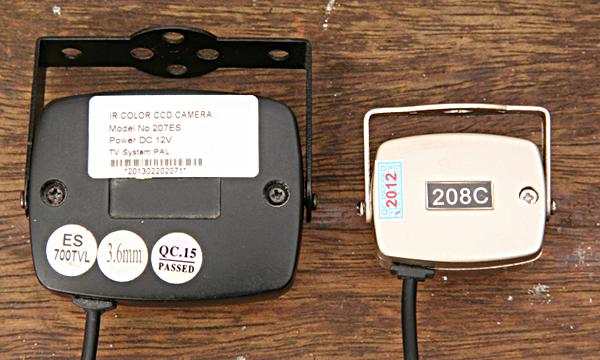
Since the year 2013, I have had video cameras in several swift nestboxes, and have also used the cameras in other situations around the garden - other nesting birds, or watching the visiting hedgehogs. Each summer, I have featured live video from the swift-boxes on a webpage here.
I'm often asked what my camera setup consists of, so I've created this page to explain, and indeed to remind myself about things noted down over the years. I don't think I'm doing anything new or original, but setting up cameras, and especially live broadcasting, can be rather daunting to anyone without a background in technology. I don't consider this page 'complete' - there is always more which could be said.


By way of explanation, the cameras I use are wired analogue cameras. 'Wireless' cameras only transmit their video by wireless, and still need a power-source, usually implying a wire. And I handled conversion of the signal to the 'digital' world centrally, for several cameras (see below).
One of the cameras from Closewatch is at left in the photo (colour black, model 207ES). Purchased in 2013, this is a colour camera (monochrome was available as well). The 'kit' versions included a video/audio/power cable (choose length required), a power-adaptor, and optional daytime lighting unit. I purchased the lighting unit with mine (more on that below), and the cable supplied came with plugs at the camera end to power both the camera and the lighting. The 'kit' also included a SCART adaptor to convert to/from composite video & audio - I've not actually used these, but they might be useful. I didn't include the USB adaptor, as I was going to use other equipment (see below) to connect to the digital/computer/internet world.
These seem good quality cameras. They have the usual 850nm wavelength infra-red illumination (visible to the human eye as a dull red glow) from 6 LEDs, switched so that it turns off when there is sufficient ambient light (the sensor for this is below the lens). The colour cameras switch to a monochrome mode when it's dark and the infra-red is on.
There is also a microphone for audio built into the camera (above the lens). I find audio useful, both for hearing what's going on, and also triggering recordings. Audio quality isn't brilliant - I always hear some mains hum. You could use a separate high-quality microphone if it was important.
At right in the photo is another model of camera I tried from another supplier (colour silver, 208C). I didn't find the quality very good (but then, they were a lot cheaper). The infra-red (this time the 940nm wavelength, invisible to the human eye) wasn't switched, so had a tendency to wash out the colour image in low-light situations. I didn't actually use these.
As far as I can tell, birds don't seem bothered by the infra-red light.
There are large numbers of different cameras available - search for things like "mini cctv camera", or even "board camera", though the latter might be just a camera module without a casing. If not obvious from the product details, things worth checking are "Does the camera include audio?" (if you want audio), and "Do the night-vision infra-red LEDs switch off in daylight?" (if they don't, then they can spoil any chance of a clear colour image in daytime).
If you want to try different lenses, then they are widely available. I bought a set of 7 ranging from 2.1mm to 16mm which only cost £13.65 (in 2013). These were from an eBay seller 'cctvsellshop' in China, website here. The eBay item was described as "7 pcs lens 2.1mm/2.8mm/3.6mm/6mm/8mm/12mm/16mm for cctv board camera system".
In practice, I have mainly used the 'standard' 3.6mm lens in my swift-boxes. In my first season of using video cameras, I used a wide-angle 2.1mm lens which, while being certain to include more of the interior of the box, made the nesting bird look a long way away, and was more likely to be affected by direct daylight coming through the entrance (definitely a bad idea to include the entrance hole in the field of view).
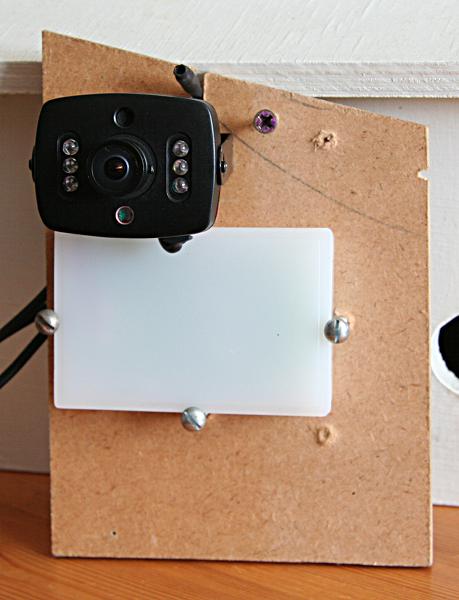
The cameras seem good at producing a colour image in low light conditions, so it's possible (depending on nest-box) that you might get a colour image just with natural light. But so far, in 2 boxes, I've always used the white-light unit.
I found, after 1 season of use, that the translucent plastic box had discoloured in front of the 4 LEDs, presumably due to heat from the LEDs. This was reducing the light output, so I removed the lid from the plastic box (it's glued, so needs a knife), and covered the front with a piece cut from an HDPE plastic milk bottle, possibly with small holes to let more light through. The LEDs are quite directional, so it's important to aim in the right direction. After a few more seasons, the units started often staying on at night (possibly not at full intensity).
See below for newer lighting units.
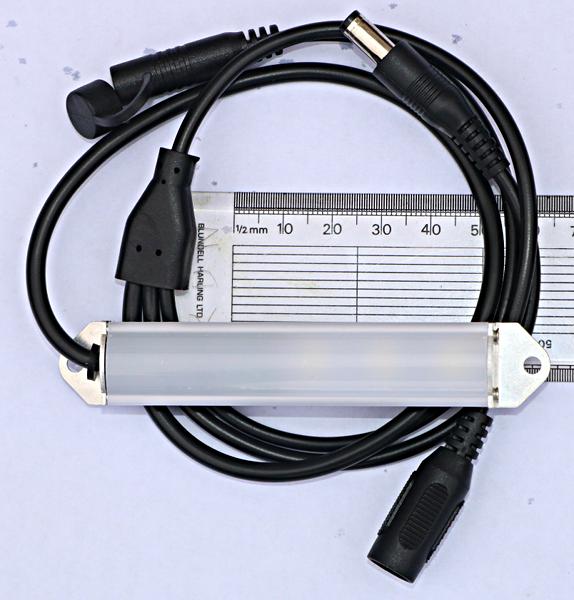
In the photo, you can see the connectors for power in, power out, and the ambient light-sensor (with cap). The 3 white LEDs are in the right-half of the unit, which might affect the decision of where to mount it.
Although I have no experience, there are probably displays intended for CCTV systems which have inputs for multiple cameras, and might cycle round them, or display several at once. Such devices might also record, perhaps triggering on motion-detection etc. One thing to watch for: someone using such a device told me that the one they use records for several minutes once it triggers, and can't be set for shorter times. With swifts moving rather a lot, this can result in too much recording to look through.
I always wanted to connect my cameras to the 'digital world' e.g. to be able to view on computer, and maybe broadcast on the web. There are USB devices for connection of cameras to computer, but I haven't used them - I often read of problems with lack of documentation, lack of drivers, or whatever. I didn't want to leave a computer running 24/7 either, so I chose a free-standing device to connect the analog cameras to the 'digital world'.
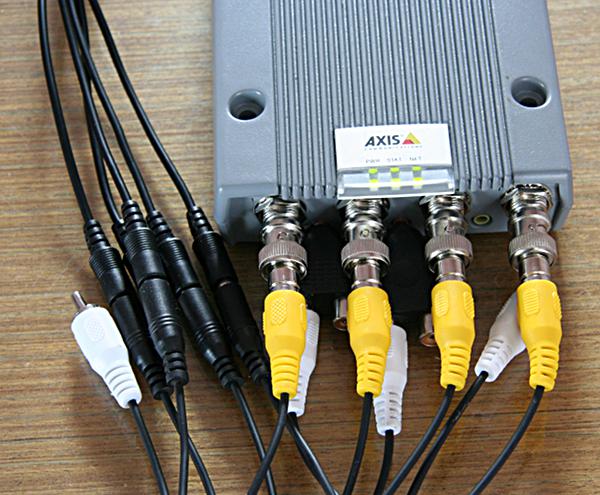
Model P7214 supports 4 video inputs from cameras, and two audio inputs. It has a slot for a micro-SD card to add storage for videos. I added a 32GB micro-SD card, which has proved to be far greater capacity than I need, but they are relatively inexpensive. The video can also be stored on a network-share, which might be appropriate if you've got a storage device on your network which is permanently switched-on.
The photo shows the 'connection end' of my P7214 encoder. There are 4 yellow composite video outputs from cameras going into sockets (via 'phono' to BNC adapters). Partly hidden below those, the white audio output from two of the cameras are connected to audio-in sockets (via 'phono' to 3.5mm stereo jack adapters) - only the white 'left' channel is used.
To the left, the black connectors are supplying power to the cameras. The encoder itself has its own mains power adaptor. It connects to the home network by ethernet cable (it can also user power-over-ethernet, but I don't have that).
The P7214 encoder is intended to be controlled via a web browser - Internet Explorer with an ActiveX control for full functionality, but other browsers (and operating systems) can do everything needed (except maybe view H.264 compressed video). For actually viewing video, I highly recommend VLC media player which is free and available for most devices and operating systems. More details below (not yet done) on the URLs needed to view video from the encoder in VLC.
Although seemingly an 'expensive' solution at the time, the Axis P7214 encoder has been everything I'd hoped. I can view live video from cameras on any computer on my network (or outside, if I allow it), and can specify that 'events' (such as motion-detected) trigger a recording to be made locally on the SD card. Recordings can be viewed and managed from a computer later.
Whilst I (and indeed anyone else I've given a username/password to) can view the video by connecting directly, this isn't really a viable solution for the 'general public' to view via the web, as it could easily exceed the encoder's ability to serve multiple video streams at the same time, and might also hit limits for 'upstream bandwidth' imposed by my home ISP. So for 'broadcasting' on the web, I use an off-site server (I had that already for other tasks), taking just one video stream from home, and duplicating it as needed for multiple viewers.